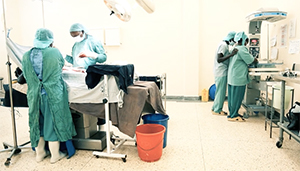- Lifebox Film Screening and Reception
- 6-7:30 p.m. Sunday
- Seaport World Trade Center, Mezzanine Level (second floor)
On Sunday, ANESTHESIOLOGY 2017 attendees are invited to attend a reception and screening of “The Checklist Effect,” which features this year’s meeting keynote speaker and Lifebox chair Atul Gawande, M.D.
“The Checklist Effect” was an official selection of the Global Health Film Festival 2016 in London and has received widespread acclaim for its depiction of anesthesia and surgery in various parts of the world.

‘The Checklist Effect’ will be presented at the Lifebox Film Screening and Reception at 6-7:30 p.m. Sunday.
Proceeds from the screening will help support Lifebox, the global nonprofit organization and ASA partner that’s made anesthesia safer for more than 10 million patients in the last six years.
Guests will have the extraordinary opportunity to meet the film’s director, Lauren Anders Brown, who will be present at its reception and screening. Learn more and purchase tickets.
The ASA Daily News caught up with her to learn how she was able to successfully tell the engaging story about the challenges and life-changing impact of our colleagues’ work the world over.
Q: What inspired you to make this film?
A: I had surgery when I was 14 years old, and nearly everyone in my immediate family has had surgery. It wasn’t hard to find inspiration to make this film when it was already all around me. Given the statistic that Americans have on average nine surgeries in their lifetime, it will be an issue I could deal with for the rest of my life. When I was introduced to the role Lifebox played in its efforts to make surgery safer, I felt compelled to try and use what skills I had to tell the story of surgery.
Q: What’s the most memorable/shocking/interesting thing you learned about anesthesia?
A: My first rough cut of this film was more than three hours long, and there was even more in the raw footage beyond that. There were a lot of stories, to say the least, that shocked and interested me, but I think the one that stuck with me the most was with Gonzalo Barreiro. He is an anesthesiologist from Uruguay (and the current president of the World Federation of Societies of Anaesthesiologists) who opened up to me about two colleagues who took their own lives due to complications with patients. I’ve learned anesthesiologists have a lot of responsibility for patients, in some ways possibly more than a surgeon. And for two people with years of medical training and experience to make such a choice, it made the crisis of unsafe surgery and anesthesia real to me.
Q: Why is this film relevant to ASA members?
A: My intention with making this film was always to make a film for anyone, and that includes ASA members. While I know explaining a pulse oximeter as an “oxygen monitor” in the film is a bit simplistic for the members here, I hope they can see how we worked to show the struggles and successes of their profession, which their patients rarely see, mostly because they’re under anesthesia when they experience it.
Q: What difference have you seen the work of Lifebox make to providers and to patients?
A: One common question I’m asked is how was I able to obtain patients’ permissions to use their stories to tell this larger story of surgery? I always feel people expect me to reveal some unknown or hidden secret of how I was able to make people open up to my camera. The secret isn’t really a secret at all, it simply all comes down to trust. The more time I was able to spend with the patients the more they trusted me, but my time was limited while filming. The trust was already embedded in these patients by their providers, and in turn by Lifebox. Their work on the ground in these different countries paved the way for these patients to want to tell their stories to my camera.
Q: Describe your style as a director.
A: I’ve had the privilege to grow up in the film industry around my father’s studio in New York City and experience all kinds of directors — feature, television and commercial. I expect most other documentary filmmakers to find their own way as I do — unexpectedly and on the job. I’ve taken my experience in narrative filmmaking working on major motion pictures and television shows and apply it to the way I shoot a documentary. But a couple of things I try to honor when I direct are firstly: be flexible, be ready to adjust and change as the story does or I may miss something. Secondly, always give my subjects the time and credit they deserve — after all, they’re the ones who make my work possible.
Q: What are some of the challenges of filming surgery/anesthesia?
A: Not having any professional medical training, I had to learn on the job how operations were performed to try to capture them in a way that told a story rather than just documented a surgery. I quickly learned that heart surgeries, although they sound very dramatic, don’t often make for dramatic filmmaking, and that things like setting a club foot actually don’t require much cutting at all. Orthopedic cases usually have the most action to film, but will have the least amount of time on the screen to save the stomachs of the audience. But the best footage that always helps to tell the story of surgery, and never ends up on the cutting room floor, is the anesthesiologist putting a patient under. There’s something about the sound and screen of the pulse oximeter that says it all.
For more information, visit www.lifebox.org/thechecklisteffect.
Return to Archive Index